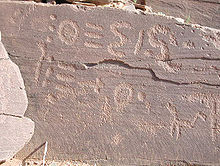
Back كتابة ليبيقية Arabic Numidische Schrift BAR Libysche Schrift German Escritura líbica Spanish Libyalainen kirjoitus Finnish Écriture libyque French ლიბიური დამწერლობა Georgian Numidisch schrift Dutch Древнеливийское письмо Russian
| Libyco-Berber alphabet | |
|---|---|
 | |
| Script type | |
Time period | Sometime during the first millennium BC to the 4th-7th century AD |
| Direction | Various, but usually bottom-to-top or right-to-left |
| Languages | Numidian language, Libyco-Berber (ancient or classical Berber language) |
| Related scripts | |
Parent systems | Egyptian hieroglyphs
|
Child systems | Tifinagh (Tuareg Tifinagh) |
The Libyco-Berber alphabet or the Libyc alphabet is an abjad writing system that was used during the first millennium BC by various Berber peoples of North Africa and the Canary Islands, to write ancient varieties of the Berber language like the Numidian language in ancient North Africa.[2][3][4][5][6]
The Libyco-Berber script is found in thousands of stone inscriptions and engravings throughout Morocco, northern Algeria, Tunisia, northern Libya and the Canary Islands, with inscriptions of the later (transitional) Saharan variant in rocky outcrops in Mali and Niger.[7]
Apart from thousands of small inscriptions, some of the best known and significant Libyco-Berber inscriptions are in the Massinissa Temple (discovered in 1904) and the Prince Ateban Mausoleum in Dougga / Thugga (TBGG), northern Tunisia. Other significant Libyco-Berber inscription are the Azib N'Ikkis[8] and the Oukaimeden,[9] both found in the High-Atlas Mountains of Morocco.
The use of the Libyco-Berber alphabet died out in northern areas during or after the reign of the Roman and Byzantine empires, but it spread south into the Sahara desert and evolved there into the Tuareg Tifinagh alphabet used by the Tuareg Berbers to this day.
- ^ oric Bates (1914). The Eastern Libyan.
- ^ "Libyco-Berber - 2nd (9th?) century BC-7th century AD". Archived from the original on 2022-06-05. Retrieved 2022-06-05.
- ^ "Libyco-Berber relations with ancient Egypt: the Tehenu in Egyptian records". Archived from the original on 2022-06-05. Retrieved 2022-06-05.
- ^ J.-B. CHABOT. — RECUEIL DES INSCRIPTIONS LIBYQUES.
- ^ L'alphabet libyque de Dougga, Lionel Galand, 1973
- ^ Inscriptions libyques, Lionel Galand, 1966
- ^ Pichler, Werner (2007). Origin and Development of the Libyco-Berber Script. Köppe. ISBN 978-3-89645-394-5.
- ^ "LBI - Libyco-Berber Inscriptions Database: Inscription details". www.institutum-canarium.org. Retrieved 2024-02-12.
- ^ "LBI - Libyco-Berber Inscriptions Database: Inscription details". www.institutum-canarium.org. Retrieved 2024-02-12.